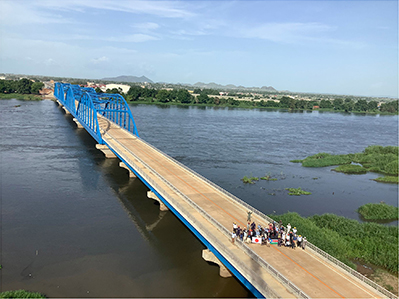Stories from the Field 01
“Freedom Bridge,” a Symbol of Freedom and Peace
—The First Large-Scale Infrastructure Construction Project in South Sudan—

Completed Freedom Bridge. It is expected to contribute to smoother logistics and economic development. (Photo: Dai Nippon Construction)

Mr. Umeda and a South Sudanese engineer delivering a lecture to the students at the University of Juba (Photo: CTI Engineering International Co., Ltd.)
South Sudan, which gained independence from Sudan in July 2011 after many years of conflict, faces a serious lack of social and economic infrastructure. As a landlocked country, South Sudan relies on land transportation for logistics, but the lack of road and bridge development is a hindrance to the country’s economic development. The Nile River, which divides the country into east and west, runs through the capital city Juba, but there was only one old bridge over the river that was built in 1972. This bridge was only able to allow one-way traffic for repairs, which significantly disrupted traffic and logistics.
In response to the situation, in 2013, Japan commenced the construction of the second bridge over the Nile River, which would form part of the international transportation corridor that connects to Uganda and to Kenya, under the grant aid “Project for Construction of Nile River Bridge.”
The original plan was to complete the construction by the end of 2016, but soon after the construction began in December 2013, it was suspended due to a conflict between the presidential faction and the vice-presidential faction. Although the construction resumed in February 2015, another conflict occurred in July 2016, and the construction was once again forced to be suspended. The construction subsequently resumed in May 2019, but in April 2020, due to the effects of the COVID-19 pandemic, it had to be suspended until March 2021.
Mr. UMEDA Norio of CTI Engineering International Co., Ltd., who served as a consultant for the construction, describes the situation at that time as follows. “While the period of the construction itself was three years and 10 months, the period of suspension of the construction totaled four years and 11 months. I learned from the reports from our South Sudanese staff, who looked after the construction site while the Japanese staff had evacuated abroad, that South Sudanese government officials often visited the site to inspect it and showed attentiveness for it. I felt that the country had high hopes for the bridge that we were building.”
After construction resumed in March 2021, it progressed smoothly with the cooperation of the South Sudanese workers. Mr. Umeda says, “They adapted well to the work that they experienced for the first time. Through their daily work, they learned many things besides techniques, such as being punctual, observing discipline, and striving to keep the work site in good order. Thanks to them, we were also able to work pleasantly.”
Furthermore, Mr. Umeda says, “South Sudan has never had such a large-scale civil engineering project. We saw the construction site as a place of learning for university students who major in civil engineering, so we invited them there to experience civil engineering work as the construction progressed and tried to transfer technology to these young people who would lead the future of the country. In addition, under the philosophy that ‘to teach is to learn twice,’ when we gave a lecture on bridge construction at a local university, I instructed South Sudanese engineers to present the project themselves.”
After three suspensions, the 560 meter long bridge was completed in May 2022, eight years and nine months after the construction began. The bridge shortened the time required to cross the Nile River and enabled large vehicles to pass safely. Through this, it is expected to facilitate international logistics, which is important for the economic development of South Sudan, the landlocked country. At the opening ceremony, President Salva Kiir and First Vice President Riek Machar also attended. The President expressed his gratitude to Japan and his hopes for recovery and peace. This bridge is called the “Freedom Bridge” and has become a symbol of peace and freedom. Japan’s cooperation leads to the recovery and development of South Sudan.
Next Page >>
Main Text | Reference Statistics | Appendix | Stories from the Field | Master Techniques from Japan to the World | ODA Topics
